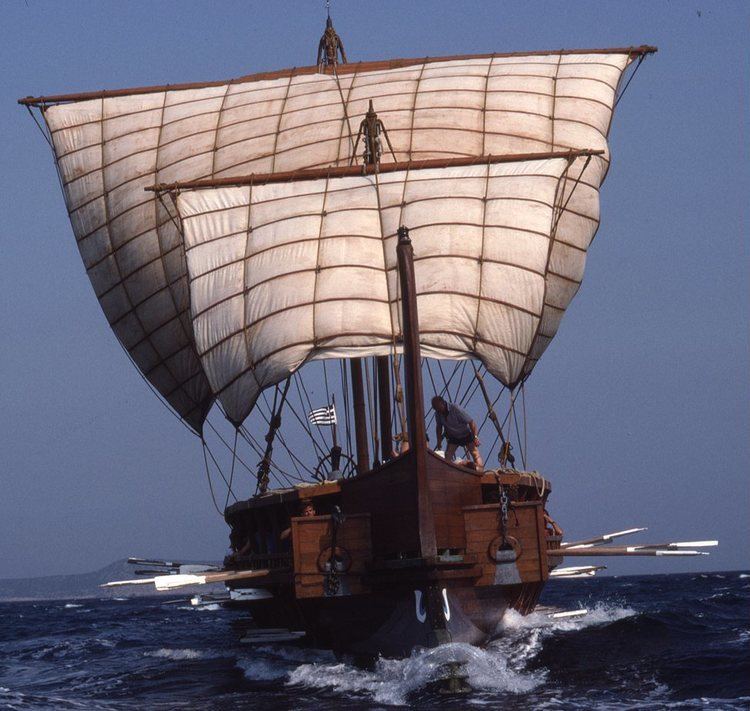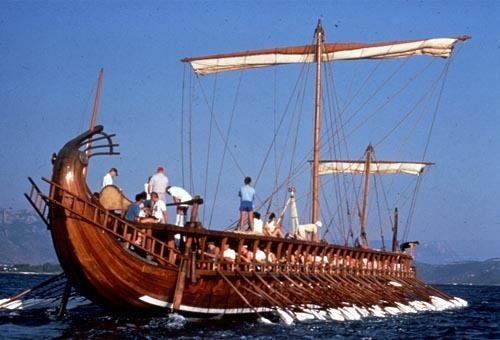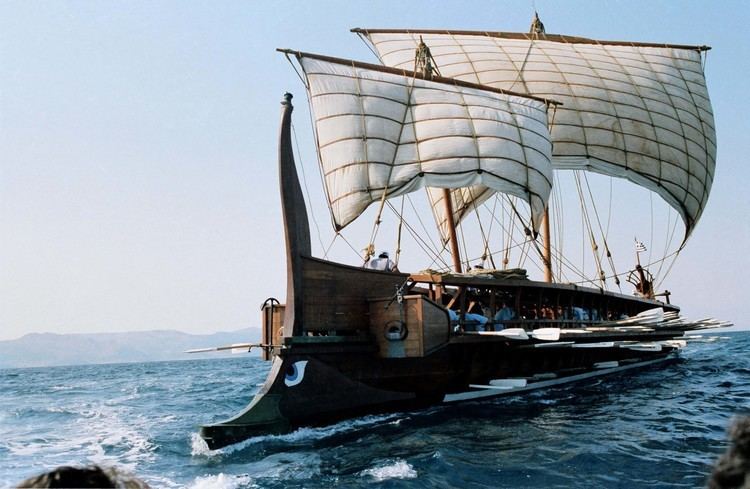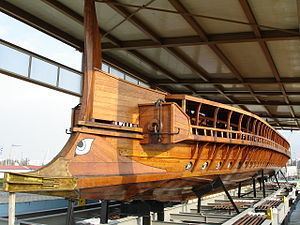Ordered 1985 Commissioned August 26, 1987 Length 37 m Launched August 1987 Weight 70 tons | Laid down July 27, 1987 Construction started 27 July 1987 Displacement 70,000 kg | |
 | ||
Status serves as exhibit in dry dock Similar Greek cruiser Georgios, USS Charrette, Hellenic Maritime Museum, Bay of Zea, Railway Museum of Athens | ||
Olympias is a reconstruction of an ancient Athenian trireme and an important example of experimental archaeology. It is also a commissioned ship in the Hellenic Navy of Greece, the only commissioned vessel of its kind in any of the world's navies.
Contents

History

Olympias was constructed from 1985 to 1987 by a shipbuilder in Piraeus. She was built to drawings by the naval architect John F. Coates which he developed through long discussions with the historian J. S. Morrison following the longest correspondence on any subject in The Times of London in the early 1980s. The work was also advised by the classics teacher Charles Willink and drew on evidence gained from Greek literature, history of art and archaeology above and below water. Finance came from the Hellenic Navy and donors such as Frank Welsh (a banker, writer and trireme enthusiast). Morrison, Coates and Willink founded the Trireme Trust together with Welsh. The Trireme Trust is now chaired by professor Boris Rankov.

The bronze bow ram weighs 200 kg. It is a copy of an original ram now in the Piraeus archaeological museum. The ship was built from Oregon pine and Virginia oak. The keel is of iroko.

The important hypozomata (bracing ropes) had to be replaced by a steel rope because no natural fibre or synthetic fibre ropes with about the same elastic modulus as hemp could be obtained. The steel cables' tension varied as the hull bent on the waves, rather than exerting constant tension like a natural fibre rope. This caused the alarming possibility of the rope breaking and endangering the crew, so protective measures had to be taken.
She underwent sea trials in 1987, 1990, 1992 and 1994, but one of the most informative was a 1987 exercise crewed by 170 volunteer oarsmen and oarswomen. Olympias achieved a speed of 9 knots (17 km/h) and was able to perform 180 degree turns within one minute, in an arc no wider than two and a half (2.5) ship-lengths. These results, achieved with an inexperienced crew, suggest that ancient historians like Thucydides were not exaggerating about the capabilities of triremes.
Olympias was transported to Britain in 1993, to take part in events celebrating the 2,500 years since the beginning of democracy. In 2004 she was used to transport the Olympic Flame ceremonially from the port of Keratsini to the main port of Piraeus, as the Olympic Torch Relay approached Athens for the 2004 Summer Olympics.
Olympias is now an exhibit in a dry dock in Palaio Faliro, Athens, Greece.
Technology
The trireme was a fast attack, light displacement vessel. In order to sustain the bending moments of her considerable length, a tightened rope (hypozomata) was mounted beneath the deck spanning from bow to stern. This was an ingenious way to increase rigidity of the hull. Today in modern construction it is called pre-tensioning. After every trip the triremes were pulled ashore in special slides and the hypozomata was re-tightened.
The trireme hulls were constructed from planks with closely spaced and pegged mortise and tenon joints. When these are fitted carefully the hull can carry shear stresses well and stay watertight.
It was estimated that her ramming speed should have been in excess of 16 knots (30 km/h), something the present reconstruction could not achieve, possibly because it was overweight.
Crew
A trireme of the classical period would have had a crew of 200, including five officers. This would be made up of:
